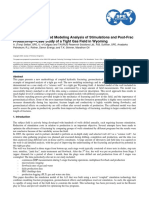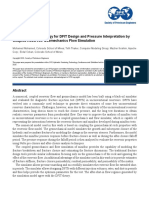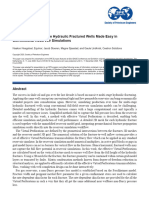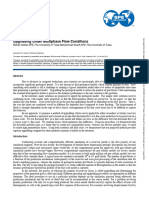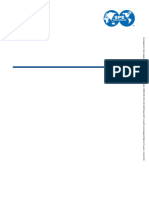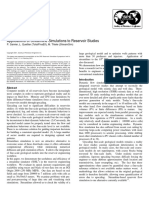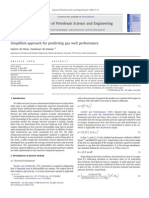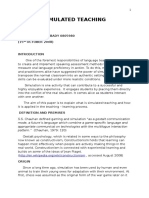SPE 153022 A Workflow For Modeling and Simulation of Hydraulic Fractures in Unconventional Gas Reservoirs
SPE 153022 A Workflow For Modeling and Simulation of Hydraulic Fractures in Unconventional Gas Reservoirs
Uploaded by
tomk2220Copyright:
Available Formats
SPE 153022 A Workflow For Modeling and Simulation of Hydraulic Fractures in Unconventional Gas Reservoirs
SPE 153022 A Workflow For Modeling and Simulation of Hydraulic Fractures in Unconventional Gas Reservoirs
Uploaded by
tomk2220Original Title
Copyright
Available Formats
Share this document
Did you find this document useful?
Is this content inappropriate?
Copyright:
Available Formats
SPE 153022 A Workflow For Modeling and Simulation of Hydraulic Fractures in Unconventional Gas Reservoirs
SPE 153022 A Workflow For Modeling and Simulation of Hydraulic Fractures in Unconventional Gas Reservoirs
Uploaded by
tomk2220Copyright:
Available Formats
SPE 153022
A Workflow for Modeling and Simulation of Hydraulic Fractures in
Unconventional Gas Reservoirs
M. Mirzaei and C.L. Cipolla, Schlumberger
Copyright 2012, Society of Petroleum Engineers
This paper was prepared for presentation at the SPE Middle East Unconventional Gas Conference and Exhibition held in Abu Dhabi, UAE, 2325 January 2012.
This paper was selected for presentation by an SPE program committee following review of information contained in an abstract submitted by the author(s). Contents of the paper have not been
reviewed by the Society of Petroleum Engineers and are subject to correction by the author(s). The material does not necessarily reflect any position of the Society of Petroleum Engineers, its
officers, or members. Electronic reproduction, distribution, or storage of any part of this paper without the written consent of the Society of Petroleum Engineers is prohibited. Permission to
reproduce in print is restricted to an abstract of not more than 300 words; illustrations may not be copied. The abstract must contain conspicuous acknowledgment of SPE copyright.
Abstract
Economic production from an unconventional gas reservoir is possible only if a complex fracture network can be created that
connects a huge reservoir area to the wellbore effectively. This fracture network can be created by hydraulic fracturing.
Several techniques can be used to present hydraulic fractures in a simulation model. In a simple model it is assumed that the
fractures lie in the single plane of local tartan grid cells that best approximates the true geometric orientation of the fracture.
The local refinement is symmetrically placed within the plane of host cells and has small cells close to the fracture that
logarithmically increase in size away from the fracture. Explicitly calculated transmissibility multipliers on the faces of the
cells that intersect the fracture are used to model the flow between matrix and the hydraulic fracture. The spacing and
conductivity of the hydraulic fractures are critical parameters that control well performance.
A new reservoir modeling and simulation technique has been developed for these complex fracture networks that
combines discrete fracture network (DFN) modeling and unstructured fracture (UF) modeling to simulate well performance
and improve stimulation design. This is very important for modeling and simulation of a well with hydraulic fractures in a
shale gas reservoir with natural fractures.
Results from this new model show a gas shale reservoir can be drained more effectively if a complex fracture network can
be created by hydraulic fracture stimulation. In addition to a large increase in the production, the number of fracture treatment
stages can be reduced if a high-conductivity fracture can be created, adding to the economic viability of the development of
unconventional gas sources. The modeling and simulation technique presented in this paper can help identify stimulation and
completion strategies that will significantly improve well performance and ultimate recovery from an unconventional gas
reservoir.
1. Introduction
In addition to well placement and spacing, completion strategy and hydraulic fracture stimulation optimization are crucial to
the economic viability of an unconventional gas reservoir. Contrary to conventional reservoirs, the key to economic success
in an unconventional reservoir is to focus on well scale rather than field scale. Successful well design, completion, and
stimulation require a very detailed geologic description of the local variation of the structure and rock properties that can
significantly affect the stress regime that controls the hydraulic fracture growth, distribution, and orientation.
Evaluating well performance and improving future completions can be difficult without coupling the hydraulic fracture
geometry and conductivity with the associated well performance (Mayerhofer et al. 2006; Cipolla 2009). To be able to
evaluate the well performance and improve the stimulation technique, it is important to properly model hydraulic fractures
and predict flow in the reservoir. However, this modeling remains a challenge in unconventional reservoirs.
Several techniques are used to model the true geometry of a hydraulic fracture alongside natural fractures present in
unconventional reservoirs. One method is to use a negative skin around the wellbore. This is simple, but the Peaceman
formula (Peaceman, 1978) may become invalid in some simulation cases and the simulation may be stopped. Another
method modifies the well productivity index (PI). This, again, is simple to do, but the elliptical profile of the pressure around
the fractured may not be captured correctly. It is also possible to modify both the well PI and near-wellbore transmissibilities
to model hydraulic fracture effect. This enables a better representation of the elliptical pressure profile. Tools exist for
matching the pressure and rate response of a fracture modeled in coarse and fine grids, or correlations can be used to provide
a cheap and a quick approximate solution. However, a refined cell geometry around the hydraulic fracture has the advantage
that the geometry of the fracture and hence its effect on the well production are more closely modeled. In an unconventional
SPE 153022
reservoir, where both natural fractures and hydraulic fractures exist as a complex network, use of local grids around hydraulic
fractures is very challenging and may not capture the true geometry of hydraulic fractures. Cipolla et al. (2011) have
introduced a new seismic-to-simulation workflow that assists in proper simulation of complex fracture propagation in such
situations. Cipolla et al. (2011) have introduced an algorithm to automatically develop discrete reservoir simulation models to
rigorously model the hydrocarbon production from complex hydraulic fractures. It has also the ability to integrate
microseismic measurements with geologic and geophysical data. The workflow is discussed in more detail in section 4.
2. Reservoir Simulation Models
Two methods are presented in this paper to model and simulate hydraulic fractures in a gas shale reservoir. In the first
approach, a conventional method is used; it assumes fractures lie in the single plane of local tartan grid cells placed around
them. In this approach a simple 3D dual-porosity reservoir model with equally spaced grid cells is created. Then local grid
sets are created in the location of hydraulic fractures in each stage of treatment.
In the second approach, it is assumed the reservoir properties and natural and hydraulic fracture geometries are complex.
An unstructured grid model based on unstructured fracture modeling (UFM) of fracture geometry (Cipolla et al. 2011) is used
to model both natural and hydraulic fractures and evaluate the effect of propped and unpropped hydraulic fracture
conductivity in gas recovery from a well in the Barnett shale play.
In the following section, a simple model is introduced to assess the effect of hydraulic fracture spacing and length,
fracture conductivity, type of shale, and matrix cell subdivision on gas recovery from a gas shale reservoir. More detail about
the reservoir simulation of a complex reservoir using UFM geometry is presented in section 4.1.
3. Simple Geometry Model
3.1 Gas Shale Reservoir Description
To represent a system of natural and hydraulic fractures in a very simple, common gas shale reservoir, a dual-porosity model
is used to simulate flow from the matrix to the fracture system. Furthermore, it is assumed the reservoir can contain either
organic-rich or lean shale: rich shale is defined as having total organic content (TOC) of 5.6 %wt, and lean shale has TOC of
1.6 %wt. Typical reservoir properties are considered for matrix and fracture. Matrix permeability of 0.0001 md and fracture
permeability of 7 md are used.
These reservoirs often have a matrix porosity system where the transient behavior becomes important. Some of the gas
may be adsorbed on the surface of the shale and some may exist as free gas in the matrix pore structure. To model such
reservoirs the dual- or multiporosity option can be used for adsorbed gas on the rock. Gas shales are organic-rich formations
in which gas is stored in the limited pore space of the rocks and a sizable fraction of the gas in place is adsorbed in the
organic materials. When organic materials are large enough to fill a simulation cell, the dual-porosity option is used to model
these reservoirs, with the matrix representing organic material and fractures representing cleats.
Contrary to the norm in conventional gas reservoirs, the Langmuir isotherm is used to specify the amount of stored gas in
the matrix in a range of reservoir pressure. The maximum storage capacity for gas is referred to as the Langmuir volume
constant and the pressure corresponding to one-half this value is referred to as the Langmuir pressure constant. This is
schematically shown in Fig. 1 for the two shale types used in this study. It is also assumed there is no water flow from matrix
to fracture or vice versa in either of these shale types.
Langmuir Volume (VL) = Gas volume at infinite pressure
VL/2
Langmuir Pressure (PL) = Pressure at VL/2
Fig. 1. Langmuir Isotherm for gas adsorption in rich and lean shales.
SPE 153022
3.2 Modeling Hydraulic Fracture by Local Grids
In this technique it is assumed the fractures lie in the single plane of local tartan grid cells that best approximates the true
geometric orientation of the fracture. The local refinement is symmetrically placed within the plane of host cells and has
small cells close to the fracture that logarithmically increase in size away from the fracture. Fig. 2 shows an example of local
grids around a hydraulic fracture. The explicitly calculated transmissibility multipliers on the faces of the cells that intersect
the fracture are used to model the flow between the matrix and the hydraulic fracture.
HF1
HF2
HF3
Well
Rich shale with nested cell subdivision
Rich shale without cell subdivision
Lean shale with nested cell subdivision
Lean shale without cell subdivision
Tartan local grids
inside host cells
Fig. 2. Single hydraulic fracture in a
local grid set (left). Host cells
containing local tartan grids are
magnified to show how global cells
hosting fracture are modeled (right).
The local refinement is symmetrically
placed within the plane of host cells
and has small cells close to the fracture
that logarithmically increase in size
away from hydraulic fracture plane. The
X, Y, and Z transmissibility multipliers
for all grid cells intercepted by the
fracture are calculated using both the
geometric properties and permeability
of the hydraulic fracture to compute the
values of these multipliers in modeling
flow from surrounding matrix to
hydraulic fracture.
Fig. 3. Pressure distribution (pressure is higher in dark blue area) after 5 years of gas
production in rich shale and lean shale with and without matrix cell subdivisions.
Production pressure remains higher in the rich gas model. In models with cell
subdivision, matrix cells are divided into five subcells to account for the transient
flow of free gas from matrix to fracture in the dual-porosity model.
3.3 Matrix cell subdivision
Fig. 3 shows the pressure distribution in 3D simulation models for both rich and lean shales containing a single hydraulic
fracture per stimulation stage after 5 years of gas production from a horizontal well. As displayed in these plots, the reservoir
area close to hydraulic fractures is drained more effectively.
In a gas shale reservoir with a reasonable amount of organic content in the matrix, the matrix porosity system often has
some gas adsorbed on the shale surface and some free gas; in this case, the transient behavior in the matrix becomes
important. To model fluid flow in such reservoirs, the multiporosity option can be used to evaluate the amount of gas
adsorbed on the rock formation. In this case, the matrix cells are divided to subcells to model both diffusive flow of adsorbed
gas from the matrix to subcells and darcy flow from subcells to the fractures surrounding the matrix.
As shown in the left plots in Fig. 3, when matrix cells are subdivided the transient behavior of gas is captured correctly,
leading to effective free and adsorbed gas drainage in matrix grid cells. This is shown in both shale types used in this paper.
As shown in these plots, the effect of transient flow from matrix to fracture is more pronounced in rich shale than in lean
shale. Plots on the right show the pressure distribution without matrix cell subdivision. In these models, there is only darcy
flow of free gas from matrix pore space to fractures and the adsorbed gas on matrix is not produced.
The results of the models on the left side of Fig. 3 are presented in Fig. 4. The black curve shows the amount of gas
production from free gas in the pore space. This is independent of the amount of TOC in the matrix and is the same in both
shale types. Stipple-dot-dot curves show the amount of produced gas from sorption. As shown, total gas production is higher
SPE 153022
in rich gas because the amount of organic matter, which is the source of sorption, in higher in rich shale with TOC of 5.6
%wt. Also, the amount of production from sorption of gas in the organic matter is small compared to the amount of gas
produced from free gas in the pore space in both shale types. However, this does not imply the small amount can be ignored.
In some marginal fields, gas produced from sorption might be vital for economic success of an unconventional field.
Fig. 5 shows the effect of matrix subdivision on gas recovery from both rich and lean shales. Solid lines show simulation
without matrix cell subdivision, and dotted lines show the results when matrix cells are subdivided to five cells. As shown,
transient flow facilitated by matrix subdivision improves cumulative gas production in both rich and lean reservoirs and leads
to earlier production of gas in both shale types.
Fig. 4. Total, free, and adsorbed gas production from lean and
rich gas shale reservoirs. Amount of adsorbed gas is lower in a
lean reservoir.
Fig. 5. Effect of matrix cell subdivision on gas recovery. Transient
flow facilitated by matrix subdivision improves cumulative gas
production in both rich and lean gas shale reservoirs.
3.4 Fracture Spacing and Length
Fracture length and spacing in each stage of a hydraulic fracturing stimulation treatment are very important. In a geologically
complex unconventional reservoir, the stress regime controls fracture orientation and growth. In this simple model it is
assumed fracture growth is in a simple horizontal plane along the plane of maximum horizontal stress. Three stages are
considered and each contains three hydraulic fractures. As shown in Design 1 in Fig. 6, when hydraulic fractures are close to
each other, a small reservoir area is in contact with the hydraulic fracture. In Design 2, fracture spacing is increased, leading
to more contact with reservoir. Therefore, gas is drained more effectively.
Design 1
Design 2
Design 3
Fig. 6. Three designs for fracture spacing and length in a rich shale model. Longer and wider-spaced hydraulic fractures
significantly improve gas drainage in an unconventional gas reservoir.
SPE 153022
Design 3 shows longer fractures than Design 2. The fracture spacing remains the same in both designs. As shown in
Design 3, increasing the fracture length leads to even more contact between fractures and the reservoir. This provides more
effective stimulation of the matrix than Design 1, hence more effective drainage of gas from the low-permeability matrix.
Production profiles of these designs are shown in Fig. 7 for both shale types. As shown, increasing fracture spacing brings
more reservoir matrix into contact with fractures, leading to earlier production and much improved gas recovery. This is
observed in both shale types. Although increasing spacing has significant effect on gas drainage, increasing the length
improves production only slightly. This may not be the case in more complex reservoirs with complex properties and fracture
networks that require effective stimulation and propping of the fractures.
3.5 Number of Hydraulic Fractures per Stage
Fig. 8 shows the effect of hydraulic fractures per stage in rich and lean shale reservoirs. Increasing the number of hydraulic
fractures per stage improves gas production. However, in an actual field, this may not be the case and the quality of
stimulation will impact production.
Fig. 7. Effect of fracture spacing and length on gas production.
Designs 13 are shown in Fig. 6.
Fig. 8. Effect of number of hydraulic fractures per stage on
gas production
3.6 Conductivity of Hydraulic Fractures
Fig. 9 shows the effect of hydraulic fracture conductivity in gas production from gas shale reservoirs considered in a simple
model. In this simple simulation model, the fracture is conductive along the full length of the fracture plane. Therefore
increasing fracture conductivity improves fluid flow and drainage of gas. This is not the case in an actual well where
conductivity of fracture along fracture plane is dominated by the quality of the reservoir and the stimulation effectiveness.
Fig. 9. Effect of fracture
conductivity on cumulative
gas production in both rich
and lean shale reservoirs.
Solid lines show the results
in rich shale and dotted lines
show the results in lean
shale. Reservoir simulations
are conducted using Design
2 in Fig. 5. To vary fracture
conductivity,
fracture
permeability is changing and
fracture
width
remains
constant.
Shale TOC=5.6 %wt
Shale TOC=1.6 %wt
SPE 153022
Having ascertained the effects of fracture length, spacing, conductivity, and number per stage in a simple model, it
becomes clear that in an unconventional reservoir it is important to understand reservoir quality, design a quality completion,
and evaluate stimulation effectiveness to understand well performance. This, however, is not a straightforward task because it
is difficult to assess unconventional reservoir quality for the design and implementation of an effective stimulation technique.
Complex depositional environments, compartmentalization, digenetic overprint on the depositional fabric, unreliable
porosity-permeability relationships, difficulty in conducting drillstem tests or pressure buildup tests, and presence of complex
natural fractures make this assessment difficult. Total drainage area, complex hydraulic fracture growth and pattern, complex
and commingled completion design, and productivity of stimulated area can vary significantly. Therefore, success of a
stimulation technique is difficult to predict.
To be able to model such complex reservoir models and evaluate the effectiveness of hydraulic fracturing stimulation,
detailed reservoir models are required that can include complex hydraulic fracture orientation, pattern, and conductivity
rigorously. Therefore an UFM needs to be created.
4. Complex UFM
A complex orthogonal unstructured grid is created (Cipolla et al. 2011) to model true geometry of hydraulic fractures in an
unconventional reservoir with natural fractures. The details of the wire-mesh and UFM used in this work differ from those of
Xu, Thiercelin, and Walton (2009), Xu et al. (2010), and Weng et al. (2011) significantly in modeling complex fracture
growth. The simpler wire-mesh model created by Xu, Thiercelin, and Walton (2009), Xu et al. (2010), and Weng et al.
(2011), approximating the complex fracture network, uses an orthogonal set of fractures, and the more sophisticated UFM
(Cipolla et al. 2011) honors the discrete fracture networks (DFN) and the mechanical properties of the natural fractures.
Further steps are added to the seismic-to-simulation workflow propsed by Cipolla et al. (2011) to make it a general
workflow for modeling, simulation, and production forecast of a well performance in a shale gas reservoir. A detailed
description of each step of the seismic-to-simulation workflow is found in Cipolla et al. (2011). White boxes in the Fig. 10
show the steps to create an unstructured grid that can model complex hydraulic fracture geometry to capture the transient
behavior of fluid flow and pressure and to model flow regimes in the reservoir and hydraulic fractures.
Seismic
Geological Structure
Faults
Natural Fractures
Rock Properties
Stress Orientation
Development Planning & Management
Microseismic Mapping
Mechanical Earth Model Hydraulic Fracture Models
1D or 3D MEM
Reservoir Model
Geological Model
Discrete Fracture Network
Logs, Core & Petrophysics
Natural Fractures
Rock Properties
Stress Profile / Anisotropy
Reservoir Properties
Production Forecast
Sensitivity & Optimization Studies
Reserve Estimates
Hydraulic Fracture Diagnostics
3D Complex Orthogonal
(Wire-mesh)
3D Complex DFN
(UFM)
Automated Grid Generation
Orthogonal
Unstructured
Completion Advisor
History Matching Parameters
Perforation Location
Staging Strategy
Fracture Half Length
Enhanced Permeability
Natural Fracture Porosity
Natural Fracture Permeability
Simulation Models
Model Calibration
Single Well Conventional
Single Well Next Gen.
Multi-well Sector Models
(Conventional/Next Gen.)
Observed MS Events & Actual
Rate and Pressure vs.
Simulated (Decline Analysis)
Rate & Pressure
Fig. 10. Workflow for modeling, simulation, and ultimate recovery forecast of a well with hydraulic fractures in an unconventional
shale gas reservoirs. The boxes highlighted in blue are new steps added to the seismic-to-simulation workflow presented by Cipolla
et al. (2011).
In addition to the detailed unstructured grid that models hydraulic fracture geometry, the distribution of fracture
conductivity must also be captured in a complex fracture model. Fracture conductivity is defined as the width of the fracture
multiplied by the fracture permeability. Depending on the effectiveness of the stimulation, fracture conductivity may vary
across the fracture plane. The location, concentration, and type of proppant used also affect fracture conductivity. The UFM
provides a detailed prediction of fracture conductivity by incorporating detailed predictions of the location and amount of
proppant within the complex fracture network.
Numerical simulation allows to optimize stimulation design, evaluate well spacing and lateral length, identify best
completion intervals, evaluate production practices, enhance asset value by developing integrated reservoir and stimulation
models to maximize NPV, provide gas/water forecasts and reserves, quantify storage and flow mechanisms and develop type
curve models. Therefore, further steps are added to the seismic-to-simulation workflow of Cipolla et al. 2011 to facilitate
using numerical simulation to answer some of the key questions in prediction of estimated ultimate recovery in
unconventional reservoirs. These steps show parameters affecting initial production and estimated ultimate recovery as well
as history matching parameters.
SPE 153022
As fracture network complexity increases, it becomes more difficult to obtain unique solutions when evaluating a
hydraulically fractured well performance. Provided that there are reasonable amount of special core analysis available to
estimate matrix permeability and unpropped natural fracture conductivity in unconventional gas reservoirs, the volume of
rock that has been stimulated by induced hydraulic fractures, the location of the proppant, the fractures half length, and
enhanced permeability of the stimulated area play major rule in well initial production history. It may be sufficient to develop
reasonable ranges for these uncertain parameters and evaluate their effect on well performance, identifying basic production
trends that can provide critical insights to improve stimulation designs and completion strategies. These uncertainties are an
inherent part of reservoir predictions. It is important to quantify them so they can be managed for field development
planning. Based on the quantification of the uncertainties field management practices may also change. Therefore it is
important to conduct further uncertainty and optimization studies to be able to improve future stimulation techniques,
estimate reserve, and evaluate economic viability of the field.
4.1 UFM of the Barnett Shale Play
For Stage 1 of the fracturing treatment of the Barnett shale play, Cipolla et al. (2011) have examined the effectiveness of
fracture conductivity on gas recovery from a treatment well using an UFM. In this paper, the lateral and vertical variation of
proppant type and concentration used in Stages 1 and 3 have been translated into fracture conductivity variation and mapped
to the reservoir simulation grid. The geomechanical effects of the stress change along the hydraulic fracture and the fracture
conductivity are also modeled and mapped into the unstructured grid.
Fig. 11a shows propped and unpropped complex fracture networks in Stages 1 and 3. Fractures in red are propped and
fractured in black are unpropped. As shown, the fracture conductivity along a single fracture plane is not constant. Fig. 11b
shows propped and unpropped fracture networks assuming the conductivity of both are equal in both stages.
(b)
(a)
Propped
Stage 3
Stage 1
Unpropped
Different conductivity in propped and unpropped fractures
Same conductivity in propped and unpropped fractures
Fig. 11. Stages 1 and 3 propped and unpropped fractures: (a) fracture conductivity is different and (b) fracture conductivity is the
same.
Fig. 12 shows complex hydraulic fracture networks in Stages 1 and 3 calibrated with microseismic measurement (Cipolla
et al. 2011). Also, the proppant distribution in the complex fracture network is shown on the right side of the figure indicating
most is located near the wellbore. This figure also shows most of the network is unpropped in both stages.
UFMs were run considering equivalent fracture conductivity in both propped and unpropped fractures in the complex
fracture network. Pressure distribution of such a case is plotted on the right in Fig. 13. The models were also run considering
different conductivities in complex propped fracture networks and constant unpropped fracture conductivity (15 md-ft).
Unpropped fracture conductivity is increased from 0.0004 md-ft to 1 md-ft. Fig. 14 shows reservoir pressure distribution
after 30 years of reservoir production for Stages 1 and 3 for different propped fracture conductivities. The top plot of Fig. 14
is the same as the left plot of Fig. 13. As shown in these figures, increased propped fracture conductivity is the key for
increased gas drainage. This is also shown in Fig. 15, which displays cumulative gas production for different conductivities
in propped and unpropped fractures compared with the constant conductivity in both propped and unpropped fractures.
Solid lines in Fig. 15 show cumulative gas production for three simulation cases in which unpropped fracture
conductivity is increasing while propped fracture conductivity remains the same. The results show that increasing unpropped
fracture conductivity improved gas recovery significantly. This may indicate that fracture conductivity of unpropped
fractures is the key for the success of gas recovery in an unconventional gas field. However if the dotted black line, which
represents cumulative gas production from a model with constant fracture conductivity of 1 md-ft for both propped and
unpropped fracture conductivity, is compared with red solid line, which shows cumulative gas production in a model with 15
md-ft propped fracture conductivity and 1 md-ft unpropped fracture conductivity, it becomes clear that the conductivity of
propped fractures is equally important.
SPE 153022
Fig. 16 shows the cumulative gas production profile of Stages 1 and 3 (solid lines) compared to a single Stage 1(stippledot lines) cumulative gas production profile for various combinations of fracture conductivity in propped and unpropped
hydraulic fractures. As shown, an effective stimulation (equivalent conductivity in both propped and unpropped fractures)
with a single-stage hydraulic fracturing treatment (black stipple-dotted line) can be as effective as a multistage treatment
(blue solid line) with an average fracture conductivity in unpropped fractures and high conductivity in propped fractures.
Fig. 12. UFM results for Stages 1 and 3 (from Cipolla et al. 2011). Microseismic measurements were used to calibrate the UFM (left).
The proppant distribution in the complex fracture network, right side, indicates most proppant is near the wellbore.
Propped =15 md-ft; Unpropped = 1 md-ft
Propped = Unpropped = 1 md-ft
Fig. 13. Pressure distribution after 30 years of production for Stages 1 and 3 in UFM fracture geometry. (Left)Pressure distribution
when fracture conductivity in propped and unpropped fractures is different. (Right) Pressure distribution when fracture conductivity
in propped and unpropped fractures is the same.
SPE 153022
Propped =15 md-ft; Unpropped = 1 md-ft
Propped =15 md-ft; Unpropped = 0.03 md-ft
Propped =15 md-ft; Unpropped = 0.0004 md-ft
Fig. 14. Pressure distribution after 30 years of production for Stages 1 and 3 in UFM fracture geometry. Fracture conductivity of
unpropped fractures remain the same (15 md-ft) but conductivity of unpropped fracture varies from as high as 1 md-ft in top figure
to as low as 0.0004 md-ft in bottom figure.
10
SPE 153022
Propped =15 md-ft
Unpropped = 1 md-ft
Propped & Unpropped =1 md-ft
Propped & Unpropped =0.5 md-ft
Propped =15 md-ft
Unpropped = 0.03 md-ft
Propped =15 md-ft
Unpropped = 0.0004 md-ft
Fig. 15. Cumulative gas production profile from Stages 1 and 3 of a treated well in the Barnett shale. Solid lines show the cumulative
gas production for UFM fracture geometries with constant propped fracture conductivity and variable unpropped fracture
conductivity as shown in Fig. 14. As displayed in this plot, increasing fracture conductivity in the unpropped regions of the
hydraulic fracture network improves gas recovery significantly. Dotted lines show the cumulative gas production for UFM fracture
geometries with constant conductivity in both propped and unpropped fracture as shown in left figure in Fig. 13. As shown by
dotted gray and dotted black lines, increasing fracture conductivity improves total gas recovery.
Stage 1
Propped & Unpropped =1 md-ft
Stage 1 and 3
Propped = 15 md.ft
Unpropped =0.03 md-ft
Stage 1 and 3
Propped =15 md-ft
Unpropped = 0.0004 md-ft
Stage 1
Propped =15 md-ft
Unpropped = 0.03 md-ft
Fig. 16. Cumulative gas production profile from Stages 1 and 3 (solid lines) compared with a single Stage 1(stipple-dot lines)
cumulative gas production profile. An effective stimulation (black stipple-dot line) with a single-stage treatment can be as effective
as a multistage (blue solid line) stimulation.
SPE 153022
11
5. Summary
The economic success of an unconventional gas shale reservoir depends on successful stimulation of wells using hydraulic
fracturing treatments. The number of treatment stages and the location, spacing, and number of fractures per stage all affect
gas recovery. Therefore accurate modeling of hydraulic fractures is required to predict production and improve future
stimulation strategies.
In an unconventional reservoir with a complex fracture network, a sophisticated workflow should be followed to create a
representative model that can capture the true network geometry. The model should be able to correctly map propped and
unpropped hydraulic fractures and transient flow from reservoir rock to hydraulic fracture. However, local variation of the
structure and rock properties, which can significantly affect the stress regimes that control the hydraulic fracture growth,
distribution, and orientation, makes modeling hydraulic fracture in an unconventional reservoir a challenge. An unstructured
complex grid can be used to overcome these challenges.
Acknowledgement
The authors thank Schlumberger for supporting this work. Special thanks must go to Anthony Fitzpatrick, Schlumberger
Abingdon Technology Centre, for his technical contribution to the unstructured grid model and to Hariharan Ramakrishnan,
Schlumberger Well Services, for his technical contribution to selection of simulation models.
References
Cipolla, C.L. 2009. Modeling Production and Evaluating Fracture Performance in Unconventional Gas Reservoirs. Paper SPE 118536; J
Pet Techol September: 8490.
Cipolla, C.L., Fitzpatrick, T., Williams, M.J., and Ganguly, U.K. 2011. Seismic-to-Simulation for Unconventional Reservoir Development.
Paper SPE 146876 presented at the SPE Reservoir Characterisation and Simulation Conference and Exhibition, Abu Dhabi, UAE, 9
11 October.
Mayerhofer, M.J., Lolon, E.P., Youngblood, J.E., and Heinze, J.R. 2006. Integration of Microseismic Fracture Mapping Results With
Numerical Fracture Network Production Modeling in the Barnett Shale. Paper SPE 102103 presented at the SPE Annual Technical
Conference and Exhibition, San Antonio, Texas, USA, 2427 September.
Peaceman, D.W., 1978. Interpretation of Well-Block Pressures in Numerical Reservoir Simulation (includes associated paper 6988). J SPE
v.18(3) June: 183-194.
Weng, X., Kresse, O., Cohen, C., Wu, R., and Gu, H. 2011. Modeling of Hydraulic Fracture Network Propagation in a Naturally Fractured
Formation. Paper SPE 140253 presented at the SPE Hydraulic Fracturing Technology Conference, The Woodlands, Texas, USA, 24
26 January.
Xu, W., Thiercelin, M.J., and Walton, I.C. 2009. Characterization of Hydraulically Induced Shale Fracture Network Using an
Analytical/Semianalytical Model, Paper SPE 124697 presented at the SPE Annual Technical Meeting, New Orleans, Louisiana,
USA, 47 October.
Xu, W., Thiercelin, M.J., Ganguly, U., Weng, X., Gu, H., Onda, H., Sun, J., and Le Calvez, J. 2010. Wiremesh: A Novel Shale Fracturing
Simulator. Paper SPE 132218 presented at the CPS/SPE International Oil and Gas Conference and Exhibition, Beijing, China, 810
June.
INTERSECT, ECLIPSE and Petrel Reference Manual
You might also like
- SPE 119394 Comprehensive Coupled Modeling Analysis of Stimulations and Post-Frac Productivity-Case Study of A Tight Gas Field in WyomingNo ratings yetSPE 119394 Comprehensive Coupled Modeling Analysis of Stimulations and Post-Frac Productivity-Case Study of A Tight Gas Field in Wyoming11 pages
- SPE-199074-MS Solving The Challenges of A Complex Integrated Production System in Camisea Field Using Novel Modeling TechniquesNo ratings yetSPE-199074-MS Solving The Challenges of A Complex Integrated Production System in Camisea Field Using Novel Modeling Techniques16 pages
- IPTC 14008 Inclusions of Well-Test Interpretation and Sector Model Simulation Into A Full Field Model: An Integration Modeling ApproachNo ratings yetIPTC 14008 Inclusions of Well-Test Interpretation and Sector Model Simulation Into A Full Field Model: An Integration Modeling Approach11 pages
- (Example) (P631 2014A) SPE Paper y Pres in PDF (SPE 124961) PDFNo ratings yet(Example) (P631 2014A) SPE Paper y Pres in PDF (SPE 124961) PDF54 pages
- 09122-11-TS-Simulation Shale Gas Reservoirs Incorporating Correct Physics Capillarity Fluid Transport-12!06!10No ratings yet09122-11-TS-Simulation Shale Gas Reservoirs Incorporating Correct Physics Capillarity Fluid Transport-12!06!105 pages
- An Overview of Iterative Coupling Between Geomechanical Deformation and Reservoir Flow Spe-97879-MsNo ratings yetAn Overview of Iterative Coupling Between Geomechanical Deformation and Reservoir Flow Spe-97879-Ms9 pages
- Corbett2010 - Numerical Reservoir ModellingNo ratings yetCorbett2010 - Numerical Reservoir Modelling10 pages
- Reservoir Modeling for Pad OptimizationNo ratings yetReservoir Modeling for Pad Optimization21 pages
- 10-2 - Production Management For Hydraulic Fracturing in Naturally Fractured Shale Gas ReservoirNo ratings yet10-2 - Production Management For Hydraulic Fracturing in Naturally Fractured Shale Gas Reservoir13 pages
- A Numerical Scheme For Optimizing Gas Liquid Cylindrical Cyclone SeparatorNo ratings yetA Numerical Scheme For Optimizing Gas Liquid Cylindrical Cyclone Separator13 pages
- SPE 144335 A New Method For History Matching and Forecasting Shale Gas Reservoir Production Performance With A Dual Porosity ModelNo ratings yetSPE 144335 A New Method For History Matching and Forecasting Shale Gas Reservoir Production Performance With A Dual Porosity Model15 pages
- SPE-200609-MS Modelling of Multi-Stage Hydraulic Fractured Wells Made Easy in Conventional Reservoir SimulationsNo ratings yetSPE-200609-MS Modelling of Multi-Stage Hydraulic Fractured Wells Made Easy in Conventional Reservoir Simulations25 pages
- Upgridding Under Multiphase Flow ConditionsNo ratings yetUpgridding Under Multiphase Flow Conditions16 pages
- IPTC IPTC-15336-PP Numerical Simulation of Hydraulic Fracturing in A Stacked Tight Gas Condensate ReservoirNo ratings yetIPTC IPTC-15336-PP Numerical Simulation of Hydraulic Fracturing in A Stacked Tight Gas Condensate Reservoir1 page
- SPE-182704-MS - A Novel IPR Calculation Technique To Reduce Oscillations in Time-Lagged Network-Reservoir Coupled Modeling Using Analytical Scaling and Fast Marching Method PDFNo ratings yetSPE-182704-MS - A Novel IPR Calculation Technique To Reduce Oscillations in Time-Lagged Network-Reservoir Coupled Modeling Using Analytical Scaling and Fast Marching Method PDF12 pages
- SPE 122594 Well Test Analysis in Naturally Fractured Gas Condensate Reservoirs Below Dew Point PressureNo ratings yetSPE 122594 Well Test Analysis in Naturally Fractured Gas Condensate Reservoirs Below Dew Point Pressure16 pages
- SPE - 93244-ms Improved Iterative Coupling of Geomechanics With Reservoir Simulation Spe-93244-MsNo ratings yetSPE - 93244-ms Improved Iterative Coupling of Geomechanics With Reservoir Simulation Spe-93244-Ms7 pages
- SHALE GAS IPTC-13338-MS-P - Sensitivity Studies of Hwells-NNo ratings yetSHALE GAS IPTC-13338-MS-P - Sensitivity Studies of Hwells-N9 pages
- Applications of Streamline Simulations To Reservoir StudiesNo ratings yetApplications of Streamline Simulations To Reservoir Studies13 pages
- SPE 144583 A Semi-Analytic Method For History Matching Fractured Shale Gas ReservoirsNo ratings yetSPE 144583 A Semi-Analytic Method For History Matching Fractured Shale Gas Reservoirs14 pages
- SPE 133877 Hydraulic Fracture Monitoring To Reservoir Simulation: Maximizing ValueNo ratings yetSPE 133877 Hydraulic Fracture Monitoring To Reservoir Simulation: Maximizing Value26 pages
- SPE196286MS - Practical Upscaling of Immiscible WAG Hysteresis Parameters From Core To Full Field Scale Part II - Talabi - 2019No ratings yetSPE196286MS - Practical Upscaling of Immiscible WAG Hysteresis Parameters From Core To Full Field Scale Part II - Talabi - 201912 pages
- SPE 182 - Robust Chemical EOR Modelling From Coreflood To Full Field Scale in A Brown Field, Offshore-Ghadami2016No ratings yetSPE 182 - Robust Chemical EOR Modelling From Coreflood To Full Field Scale in A Brown Field, Offshore-Ghadami201619 pages
- Compartment Model Approach: Mixing in Large Scale Aerated Reactors With Multiple ImpellersNo ratings yetCompartment Model Approach: Mixing in Large Scale Aerated Reactors With Multiple Impellers12 pages
- 2015, Shahid, A Review of Numerical Simulation Strategies for Hydraulic Fracturing, Natural Fracture Reactivation and Induced Microseismicity PredictionNo ratings yet2015, Shahid, A Review of Numerical Simulation Strategies for Hydraulic Fracturing, Natural Fracture Reactivation and Induced Microseismicity Prediction20 pages
- SPE-170761-MS Structural Uncertainty Integration Within Reservoir Risk Analysis and History MatchingNo ratings yetSPE-170761-MS Structural Uncertainty Integration Within Reservoir Risk Analysis and History Matching11 pages
- IPTC-19288-MS A Reservoir and Geomechanical Coupling Simulation Method: Case Studies in Shale Gas and CBM ReservoirNo ratings yetIPTC-19288-MS A Reservoir and Geomechanical Coupling Simulation Method: Case Studies in Shale Gas and CBM Reservoir20 pages
- SPE-173269-MS A Comprehensive Reservoir Simulator For Unconventional Reservoirs Based On The Fast Marching Method and Diffusive Time of FlightNo ratings yetSPE-173269-MS A Comprehensive Reservoir Simulator For Unconventional Reservoirs Based On The Fast Marching Method and Diffusive Time of Flight22 pages
- SPE 79698 Coupled Analysis of Geomechanics and Fluid Flow in Reservoir SimulationNo ratings yetSPE 79698 Coupled Analysis of Geomechanics and Fluid Flow in Reservoir Simulation16 pages
- ubulom-2020-influence-of-fluid-structure-interaction-modelling-on-the-stress-and-fatigue-life-evaluation-of-a-gasNo ratings yetubulom-2020-influence-of-fluid-structure-interaction-modelling-on-the-stress-and-fatigue-life-evaluation-of-a-gas20 pages
- Geological Carbon Storage: Subsurface Seals and Caprock IntegrityFrom EverandGeological Carbon Storage: Subsurface Seals and Caprock IntegrityStéphanie VialleNo ratings yet
- Application of Decline Analysis in Fractured ReservoirsNo ratings yetApplication of Decline Analysis in Fractured Reservoirs10 pages
- SPE Estimating Gas Desorption Parameters From Devonian Shale Well Test DataNo ratings yetSPE Estimating Gas Desorption Parameters From Devonian Shale Well Test Data12 pages
- Journal of Petroleum Science and Engineering: Hazim Al-Attar, Sulaiman Al-ZuhairNo ratings yetJournal of Petroleum Science and Engineering: Hazim Al-Attar, Sulaiman Al-Zuhair11 pages
- Anita Malhotra Vs Apparel Export Promotion Councils111181COM986059No ratings yetAnita Malhotra Vs Apparel Export Promotion Councils111181COM9860598 pages
- Printable 2024 Calendars Business 2 LandscapeNo ratings yetPrintable 2024 Calendars Business 2 Landscape12 pages
- Placement Willingness new CSE 2026 Batch(1-330)No ratings yetPlacement Willingness new CSE 2026 Batch(1-330)46 pages
- The Strategic Impact Model An IntegrativNo ratings yetThe Strategic Impact Model An Integrativ2 pages
- How We Organize Ourselves Parent Letter 2011No ratings yetHow We Organize Ourselves Parent Letter 20112 pages
- Full Download British News Media and the Spanish Civil War Tomorrow May Be Too Late 1st Edition Deacon PDF DOCX100% (3)Full Download British News Media and the Spanish Civil War Tomorrow May Be Too Late 1st Edition Deacon PDF DOCX81 pages
- Hans Kelsens Pure Theory of Law and HLA Harts Positivism, Luhman N PoundNo ratings yetHans Kelsens Pure Theory of Law and HLA Harts Positivism, Luhman N Pound76 pages
- Common Expressions For Discussion: Word List On CommentsNo ratings yetCommon Expressions For Discussion: Word List On Comments59 pages
- 2016-2017 COURSE SYLLABUS: Grady High SchoolNo ratings yet2016-2017 COURSE SYLLABUS: Grady High School4 pages
- SPE 119394 Comprehensive Coupled Modeling Analysis of Stimulations and Post-Frac Productivity-Case Study of A Tight Gas Field in WyomingSPE 119394 Comprehensive Coupled Modeling Analysis of Stimulations and Post-Frac Productivity-Case Study of A Tight Gas Field in Wyoming
- SPE-199074-MS Solving The Challenges of A Complex Integrated Production System in Camisea Field Using Novel Modeling TechniquesSPE-199074-MS Solving The Challenges of A Complex Integrated Production System in Camisea Field Using Novel Modeling Techniques
- IPTC 14008 Inclusions of Well-Test Interpretation and Sector Model Simulation Into A Full Field Model: An Integration Modeling ApproachIPTC 14008 Inclusions of Well-Test Interpretation and Sector Model Simulation Into A Full Field Model: An Integration Modeling Approach
- (Example) (P631 2014A) SPE Paper y Pres in PDF (SPE 124961) PDF(Example) (P631 2014A) SPE Paper y Pres in PDF (SPE 124961) PDF
- 09122-11-TS-Simulation Shale Gas Reservoirs Incorporating Correct Physics Capillarity Fluid Transport-12!06!1009122-11-TS-Simulation Shale Gas Reservoirs Incorporating Correct Physics Capillarity Fluid Transport-12!06!10
- An Overview of Iterative Coupling Between Geomechanical Deformation and Reservoir Flow Spe-97879-MsAn Overview of Iterative Coupling Between Geomechanical Deformation and Reservoir Flow Spe-97879-Ms
- 10-2 - Production Management For Hydraulic Fracturing in Naturally Fractured Shale Gas Reservoir10-2 - Production Management For Hydraulic Fracturing in Naturally Fractured Shale Gas Reservoir
- A Numerical Scheme For Optimizing Gas Liquid Cylindrical Cyclone SeparatorA Numerical Scheme For Optimizing Gas Liquid Cylindrical Cyclone Separator
- SPE 144335 A New Method For History Matching and Forecasting Shale Gas Reservoir Production Performance With A Dual Porosity ModelSPE 144335 A New Method For History Matching and Forecasting Shale Gas Reservoir Production Performance With A Dual Porosity Model
- SPE-200609-MS Modelling of Multi-Stage Hydraulic Fractured Wells Made Easy in Conventional Reservoir SimulationsSPE-200609-MS Modelling of Multi-Stage Hydraulic Fractured Wells Made Easy in Conventional Reservoir Simulations
- IPTC IPTC-15336-PP Numerical Simulation of Hydraulic Fracturing in A Stacked Tight Gas Condensate ReservoirIPTC IPTC-15336-PP Numerical Simulation of Hydraulic Fracturing in A Stacked Tight Gas Condensate Reservoir
- SPE-182704-MS - A Novel IPR Calculation Technique To Reduce Oscillations in Time-Lagged Network-Reservoir Coupled Modeling Using Analytical Scaling and Fast Marching Method PDFSPE-182704-MS - A Novel IPR Calculation Technique To Reduce Oscillations in Time-Lagged Network-Reservoir Coupled Modeling Using Analytical Scaling and Fast Marching Method PDF
- SPE 122594 Well Test Analysis in Naturally Fractured Gas Condensate Reservoirs Below Dew Point PressureSPE 122594 Well Test Analysis in Naturally Fractured Gas Condensate Reservoirs Below Dew Point Pressure
- SPE - 93244-ms Improved Iterative Coupling of Geomechanics With Reservoir Simulation Spe-93244-MsSPE - 93244-ms Improved Iterative Coupling of Geomechanics With Reservoir Simulation Spe-93244-Ms
- SHALE GAS IPTC-13338-MS-P - Sensitivity Studies of Hwells-NSHALE GAS IPTC-13338-MS-P - Sensitivity Studies of Hwells-N
- Applications of Streamline Simulations To Reservoir StudiesApplications of Streamline Simulations To Reservoir Studies
- SPE 144583 A Semi-Analytic Method For History Matching Fractured Shale Gas ReservoirsSPE 144583 A Semi-Analytic Method For History Matching Fractured Shale Gas Reservoirs
- SPE 133877 Hydraulic Fracture Monitoring To Reservoir Simulation: Maximizing ValueSPE 133877 Hydraulic Fracture Monitoring To Reservoir Simulation: Maximizing Value
- SPE196286MS - Practical Upscaling of Immiscible WAG Hysteresis Parameters From Core To Full Field Scale Part II - Talabi - 2019SPE196286MS - Practical Upscaling of Immiscible WAG Hysteresis Parameters From Core To Full Field Scale Part II - Talabi - 2019
- SPE 182 - Robust Chemical EOR Modelling From Coreflood To Full Field Scale in A Brown Field, Offshore-Ghadami2016SPE 182 - Robust Chemical EOR Modelling From Coreflood To Full Field Scale in A Brown Field, Offshore-Ghadami2016
- Compartment Model Approach: Mixing in Large Scale Aerated Reactors With Multiple ImpellersCompartment Model Approach: Mixing in Large Scale Aerated Reactors With Multiple Impellers
- 2015, Shahid, A Review of Numerical Simulation Strategies for Hydraulic Fracturing, Natural Fracture Reactivation and Induced Microseismicity Prediction2015, Shahid, A Review of Numerical Simulation Strategies for Hydraulic Fracturing, Natural Fracture Reactivation and Induced Microseismicity Prediction
- SPE-170761-MS Structural Uncertainty Integration Within Reservoir Risk Analysis and History MatchingSPE-170761-MS Structural Uncertainty Integration Within Reservoir Risk Analysis and History Matching
- IPTC-19288-MS A Reservoir and Geomechanical Coupling Simulation Method: Case Studies in Shale Gas and CBM ReservoirIPTC-19288-MS A Reservoir and Geomechanical Coupling Simulation Method: Case Studies in Shale Gas and CBM Reservoir
- SPE-173269-MS A Comprehensive Reservoir Simulator For Unconventional Reservoirs Based On The Fast Marching Method and Diffusive Time of FlightSPE-173269-MS A Comprehensive Reservoir Simulator For Unconventional Reservoirs Based On The Fast Marching Method and Diffusive Time of Flight
- SPE 79698 Coupled Analysis of Geomechanics and Fluid Flow in Reservoir SimulationSPE 79698 Coupled Analysis of Geomechanics and Fluid Flow in Reservoir Simulation
- ubulom-2020-influence-of-fluid-structure-interaction-modelling-on-the-stress-and-fatigue-life-evaluation-of-a-gasubulom-2020-influence-of-fluid-structure-interaction-modelling-on-the-stress-and-fatigue-life-evaluation-of-a-gas
- Geological Carbon Storage: Subsurface Seals and Caprock IntegrityFrom EverandGeological Carbon Storage: Subsurface Seals and Caprock Integrity
- Application of Decline Analysis in Fractured ReservoirsApplication of Decline Analysis in Fractured Reservoirs
- SPE Estimating Gas Desorption Parameters From Devonian Shale Well Test DataSPE Estimating Gas Desorption Parameters From Devonian Shale Well Test Data
- Journal of Petroleum Science and Engineering: Hazim Al-Attar, Sulaiman Al-ZuhairJournal of Petroleum Science and Engineering: Hazim Al-Attar, Sulaiman Al-Zuhair
- Anita Malhotra Vs Apparel Export Promotion Councils111181COM986059Anita Malhotra Vs Apparel Export Promotion Councils111181COM986059
- Full Download British News Media and the Spanish Civil War Tomorrow May Be Too Late 1st Edition Deacon PDF DOCXFull Download British News Media and the Spanish Civil War Tomorrow May Be Too Late 1st Edition Deacon PDF DOCX
- Hans Kelsens Pure Theory of Law and HLA Harts Positivism, Luhman N PoundHans Kelsens Pure Theory of Law and HLA Harts Positivism, Luhman N Pound
- Common Expressions For Discussion: Word List On CommentsCommon Expressions For Discussion: Word List On Comments




